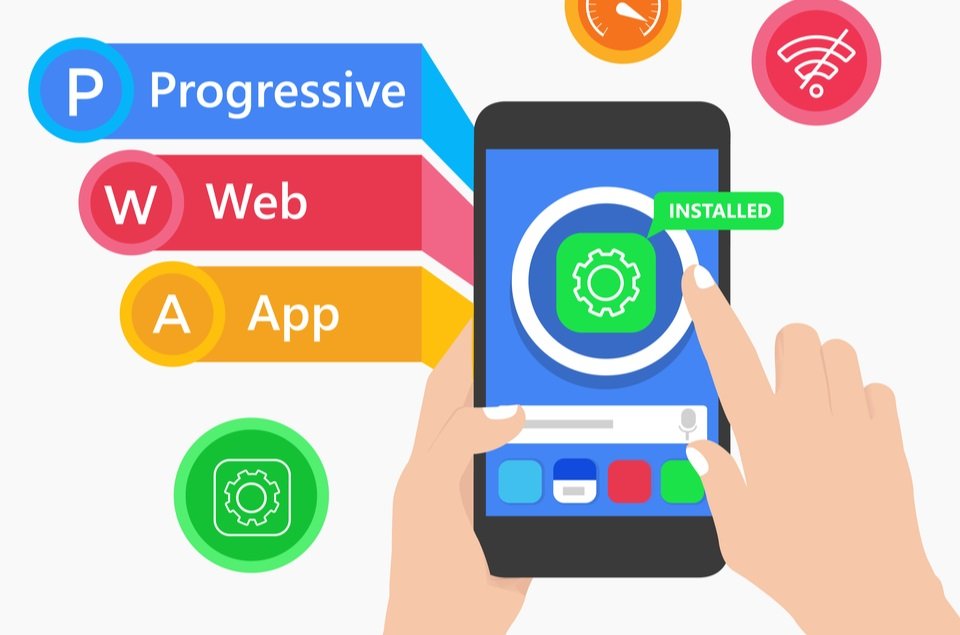In today’s fast world, businesses look for new ways to connect with customers. Progressive Web Apps (PWAs) are a big step forward. They mix the web’s reach with mobile app’s speed, making things easy for users on many devices.
At the core of PWA development are new web techs like service workers and app manifests. This mix lets businesses give fast, reliable, and fun digital experiences. No need for app stores or long installs. With pwa development services, companies can win more customers, make more sales, and get noticed more.

Key Takeaways
- Progressive Web Apps (PWAs) offer the best of web and mobile app experiences.
- PWA development combines cutting-edge web technologies to deliver fast, reliable, and engaging digital experiences.
- Businesses can leverage PWAs to enhance customer loyalty, increase conversions, and boost brand recognition.
- A progressive web app development company can help businesses unlock the full potential of PWA technology.
- pwa development services can provide a competitive edge in today’s digital landscape.
Understanding Progressive Web Applications: The Future of Web Development
The digital world is changing fast, and progressive web applications (PWAs) are leading the way. PWAs mix the best of websites and apps, giving users a smooth experience on any device.
Core Features of Progressive Web Apps
PWAs have key features that set them apart. These include:
- Offline functionality: PWAs work without internet, making them perfect for areas with bad connections.
- Instant loading: They load quickly, keeping users engaged and happy.
- Push notifications: PWAs send timely updates, keeping users interested and coming back.
- Responsiveness: They fit any screen size, ensuring a great experience on all devices.
Benefits for Business Operations
Businesses gain a lot from using PWAs. Some benefits are:
- Lower costs: PWAs use one codebase for all platforms, saving on development and updates.
- Better user engagement: Their app-like feel and fast loading keep users coming back.
- Improved performance: PWAs are fast and reliable, even in tough internet conditions.
PWA vs. Traditional Mobile Apps
PWAs offer a new choice for businesses, unlike traditional mobile apps. They give a similar experience without needing a separate app. This means easier access and a smoother user journey.

The Evolution of Mobile-First Web Development
The web development world has changed a lot, focusing more on mobile-first web apps and progressive web app (PWA) builders. This change shows how much we rely on mobile devices for the internet.
Before, web development mainly aimed at desktops. But as mobile use grew, the focus shifted to mobile-friendly designs. Now, we have responsive web design and mobile-first methods, making the web more accessible.
Progressive web apps are a big step forward. They mix web and mobile tech. PWA app builders help developers make apps that work like native ones but are still web-based.
What’s driving this change? Mainly:
- More people using mobile devices and wanting mobile-focused sites
- New web tech like service workers and app manifests
- Focus on fast, smooth experiences for users
- Need for web apps that work on all devices
- Want for apps that work offline and seamlessly
As the web keeps evolving, mobile-first web apps and pwa app builders will play bigger roles. They’ll shape digital experiences and change how businesses connect with people.
| Feature | Traditional Mobile Apps | Progressive Web Apps |
|---|---|---|
| Installation | Requires download and installation from app stores | Can be accessed directly through a web browser, no installation required |
| Offline Capabilities | Offer limited offline functionality | Provide seamless offline access and offline-first capabilities |
| Updates | Require manual updates through app stores | Automatically updated in the background, ensuring users always have the latest version |
| Discoverability | Limited to app store search and ranking algorithms | Easily discoverable through web search engines and shared links |
The shift to mobile-first web development and PWA app builders has changed the digital world. It gives businesses new ways to reach people and offer great mobile experiences.

Key Components That Make PWAs Stand Out
Progressive Web Apps (PWAs) have changed how we use the web. They offer a mix of features that make them special. At their heart are several key parts that help them work well and keep users interested.
Service Workers and Caching Strategies
Service workers are key to PWAs. They act as a bridge between the web and the network. They make it possible to use apps offline, cache data, and sync in the background.
By caching important files, service workers make apps load fast. This gives users a smooth experience.
Push Notifications and User Engagement
PWAs can send push notifications. This lets businesses talk to users in real-time. They can share updates, deals, or news.
These notifications help keep users involved. Even when they’re not using the app, they can stay updated.
App Manifest Implementation
The app manifest is vital for PWAs. It tells the app how to look and act. It includes details like the app’s name, icons, and how it should be displayed.
With a good app manifest, PWAs can be installed on the home screen. This makes for a more immersive web experience.
These main parts, along with other PWA benefits, make them a great choice. They offer pwa design and development and installable web experiences that grab attention.
Choosing the Right Progressive Web App Development Company
Finding the right company for your progressive web app (PWA) is key to success. A good PWA partner can unlock the tech’s full potential. This keeps your business leading the way. When looking at companies, there are important things to check.
First, check if the company has a strong track record in PWA development. Look at their past projects and what clients say. A progressive web app development company should know the latest PWA tech and practices. This ensures they can create solutions that really help your business.
| Criteria | Importance |
|---|---|
| Proven PWA Development Expertise | High |
| Understanding of Your Industry | High |
| Ability to Deliver Measurable Results | High |
| Collaborative and Transparent Approach | Medium |
| Competitive Pricing and Value | Medium |
Also, find a pwa development services provider that gets your business and industry. Their deep understanding will help them create PWA solutions that meet your specific needs. This will bring real value to your company.
By looking at these points, you can find the best progressive web app development company to work with. This sets you up for a successful PWA project that moves your business forward in the digital world.
Essential Features of Modern PWA Design and Development
The success of a progressive web app (PWA) depends on its design and development. Designers and developers must focus on three key areas. These are responsive design, performance optimization, and strong security.
Responsive Design Principles
Responsiveness is key in modern PWA design. PWAs must work well on all screen sizes and devices. This ensures users have a great experience, no matter what they’re using.
By following responsive web design best practices, teams can make sure their apps look and work great. This includes using fluid grids, flexible images, and media queries. This way, PWAs look and function well on smartphones, tablets, and desktops.
Performance Optimization Techniques
PWAs are known for their fast performance. To achieve this, developers use techniques like code splitting and image optimization. They also use progressive loading.
By making files smaller, focusing on what’s most important, and using caching, PWAs load quickly. This makes for a smooth and responsive user experience.
Security Implementation Standards
User data security is crucial in today’s online world. PWA designers and developers must follow the highest security standards. This includes using HTTPS, service workers for offline access, and strong authentication.
By focusing on security, PWA teams can build trust with users. They also protect user data, which is essential.
Mastering these essential features helps businesses create mobile-first web apps. These apps captivate users, optimize performance, and prioritize security. All these are vital for success in today’s digital world.
Building Offline-Capable Websites with PWA Technology
In today’s world, having a website that works offline is key. Progressive Web Apps (PWAs) make this possible. They help businesses create websites that work even when there’s no internet.
PWA technology uses Service Workers to cache important resources. This means websites can still work when there’s no internet. It makes sure users can always use your website, improving their experience.
Implementing Offline Capabilities in PWAs
To make websites work offline with PWAs, you need to follow some steps:
- Service Worker Integration: Service Workers help websites work offline by caching content.
- Caching Strategies: Developers use different caching methods to make websites load fast offline.
- App Shell Architecture: This method caches the main UI parts, so they load quickly offline.
- Offline-First Design: Designing websites to work offline first makes them more reliable.
By using these PWA technologies, businesses can make offline-capable websites. These websites let customers use your products and services, even without internet.
The Benefits of Offline-Capable PWAs
Offline-capable PWAs bring many benefits to businesses:
- Improved User Experience: Websites that work offline make users happier and more engaged.
- Increased Accessibility: Offline websites reach more people, even in areas with bad internet.
- Competitive Advantage: Offering offline websites sets businesses apart from their competitors.
As more people want websites that work well offline, using PWA app builders is becoming more important. It helps businesses stay ahead and give their customers great digital experiences.
| Feature | Benefit |
|---|---|
| Offline Functionality | Users can access and interact with the website even in low-connectivity or offline environments |
| Caching Strategies | Essential resources are cached, ensuring fast loading times and seamless user experiences |
| App Shell Architecture | The core UI elements are pre-loaded, providing a consistent and reliable user interface |
| Offline-First Design | The website is designed with the offline user in mind, prioritizing functionality and accessibility |
“Offline-capable websites powered by PWA technology are the future of modern web development, enabling businesses to deliver uninterrupted digital experiences to their customers regardless of network conditions.”
PWA Development Best Practices for Business Success
Progressive web applications (PWAs) are changing the digital world. Businesses need to keep up by using the best PWA development practices. This means improving performance, making the user experience better, and working well on different platforms. This way, companies can make the most of PWAs and succeed.
Performance Metrics and Optimization
Creating efficient PWAs is key for a great user experience. Businesses should watch important performance metrics like loading times and page speed. They should use the latest optimization methods, like code minification and caching, to make the PWA faster.
User Experience Enhancement Strategies
A great PWA needs a wonderful user experience. Developers should aim for easy-to-use interfaces and smooth interactions. Listening to user feedback and using it to improve the design is also important. This ensures the PWA meets the needs of its users.

Cross-Platform Compatibility
PWAs need to work well on all devices and platforms to reach more people. They should be designed with mobile users in mind. Following best practices like responsive design helps ensure a good experience for everyone, no matter their device.
By following these best practices, businesses can use PWAs to engage customers better, work more efficiently, and succeed in the digital world.
| Performance Metrics | User Experience Strategies | Cross-Platform Compatibility |
|---|---|---|
| Loading times Page speed Response times | Intuitive interfaces Smooth transitions Easy navigation | Responsive design Adaptive layout Feature detection |
“The future of web development lies in progressive web applications, which offer businesses a powerful and versatile platform to engage with their customers and drive growth.”
Installing and Distributing Your Progressive Web App
Releasing your Progressive Web App (PWA) is just the start. To really make it shine, focus on easy installation and smart distribution. This guide will help you make your PWA easy to find and loved by your audience.
PWAs stand out because they can be installed directly on devices. This makes them feel like real apps. By following a few steps, your PWA can be added to a user’s home screen. It will have an app-like icon and work smoothly, without needing a separate app download.
But it’s not just about installing. Getting your PWA out there is key to its success. Use app stores to reach more people and offer a familiar setup. Also, promote your PWA on your website, social media, and through marketing. This will help more people know about it and use it.
FAQ
What is a progressive web app (PWA)?
A progressive web app is a mix of a website and a mobile app. It offers a fast and reliable experience. It feels like a native app but is accessible like a website.
What are the core features of a progressive web app?
PWAs have key features like service workers for offline use. They also have a web app manifest for installation and push notifications for engagement. They use responsive design and security to provide a top-notch experience.
What are the benefits of using a progressive web app for my business?
PWAs improve user engagement and cut down on costs. They are faster to develop and maintain. They also work well on all devices and are easier to find online than traditional apps.
How do progressive web apps differ from traditional mobile apps?
PWAs are built with web tech and accessed through browsers. Mobile apps are for specific platforms and found in app stores. PWAs offer offline use, instant install, and a smoother experience than traditional apps.
What are the essential components of a well-designed progressive web app?
A good PWA has a mobile-first design and fast performance. It uses HTTPS for security and a web app manifest for installation. It also has service workers for offline use and push notifications for engagement.
How do I choose the right progressive web app development company?
Look for a company with a track record of quality PWAs. Check their technical skills, project success, and understanding of your needs. Make sure they follow best practices in PWA design and development.
How can I make my progressive web app work offline?
Use service workers to enable offline functionality. These scripts run in the background and cache resources. This way, your PWA works even without internet.
What are the best practices for building a successful progressive web app?
Optimize performance with code splitting and lazy loading. Ensure a responsive design and strong security. Use push notifications and test your PWA on various devices and browsers for compatibility.
How do I distribute and install my progressive web app?
You can distribute your PWA through a browser or app stores. It needs a web app manifest for installation. Users can then install it on their home screen for a seamless experience.






